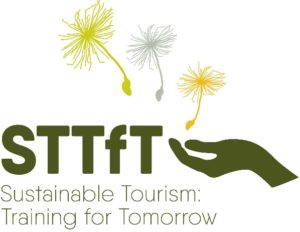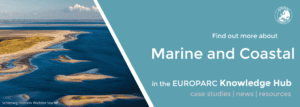BLUEBRO Project: Kayaking Adventure for Environmental Conservation
©BLUREBRO project
Kayaking almost 1000 km of the longest river in Spain, the Ebro, in order to highlight the environmental problems of such an important ecosystem as well as to raise awareness about sustainable and respectful practices towards nature in our daily lives. Read a testimony from the BLUEBRO project, written by its youngest team member and former intern at EUROPARC, Alberto Robles.
Bluebro: An adventure at the service of sustainability
A team of four kayakers (plus another four support members outside water) have crossed 7 Spanish regions during 24 stages, 930km in total, in order to raise awareness of the importance of water as an indispensable resource for our life, health, biodiversity and agriculture.
Through this epic challenge of a cross-cutting and multi-generational nature, the aim is to draw the attention of each and every individual in society who needs and uses the water resources of rivers on a daily basis. The metaphor of the river’s course and its life cycle has been used to make a comparison with human beings and their demands in terms of natural resources to develop any type of economic activity.
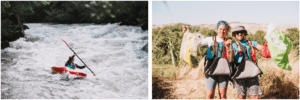
©BLUREBRO project
Alberto Robles, the youngest of the team members (24) and former intern at EUROPARC Federation, explains how he has perceived this experience from the water and the learning about such important issues as pollution, plastics in the river, water uses, sediments, recreational uses:
”According to the testimonies of the actors that we have met along the way (organizations, politicians, businessmen, farmers, fishermen, biologists…), the situation of the river shows an improvement tendency in the last 10 years due to the environmental protection actions that have been carried out. This is the positive side of the story and the basis that will help to continue evolving towards a sustainable future, but today it must be made clear that it is still insufficient and that our consumption of natural resources is still generating a deficit.”
Witnessing the reality of the earth’s ecosystems
The change of perspective is one of the crucial points of the project: ”When you cross 930km through water, going into forests and all kinds of landscapes, you understand better what we are doing to the planet”.
This is where a factor that can be considered a risk for environmental protection, such as Outdoor Sports, becomes a tool at the service of nature: ”from our kayak we have been able to witness first hand what happens to nature, and then report it and communicate it to the society.”
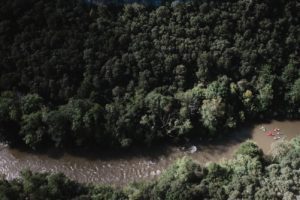
©BLUREBRO project
Spreading the message
Communication is one of the central objectives of the project: ”In the end we are just telling a story, about the relationship of humans with nature and, in this case, with water.”
It’s all about connecting with the emotions transmitted by outdoor sports to deliver a message of environmental conservation.
With this objective, in addition to communication on media and social networks, the participants will present a documentary during the year 2021 in which they tell us about their adventure.
The project and Protected Areas
The change in the landscape and conditions of different regions or even local areas can be identified very well along the route, within which the Protected Areas should be highlighted, as they show a clear positive difference in terms of nature management, which is the first visual indicator that the work is being carried out properly.
Among the Protected Areas we have passed through, such as the important natural parks of Hoces del Ebro and Delta del Ebro, we have had the privilege of talking to some of the protagonists of their development, who made us understand the problems these hot spots face:
- Obstacles in the path of the water / Ecological alteration (dams and transfers): problems of sediments, nutrients and management of aquifers.
- Pollution: plastics and waste of different origins, intensive agriculture (fertilizers), and intensive livestock farming (slurry).
- Abuse in the use of water: excessive use implies transfers that alter all natural cycles while creating serious problems in the main river.
- Invasive species: one of the main problems (zebra mussel or apple snail) and a direct consequence of the above-mentioned disturbances and problems.
- Climate change: reduction of rainfall, which globally means a 1% loss of water abstraction in the river basins of Spain (20% less water availability in 2050).
Visit the official website of the project to find out about the in-depth adventure as well as the environmental reflections and calls for action!
Next webinar: How to plan and mange a park for nature and people: the experience of Periurban Parks
Join our next webinar on the 4th of December at 11 AM CET: How to plan and mange a Park for nature and people: the experience of Periurban Parks
Periurban Parks have the double mission of preserving biodiversity and delivering key ecosystem services to the city, while also meeting the need for outdoor recreation and nature contact from an increasingly numerous and demanding urban population. Planning and managing to meet these, sometimes, conflicting needs is highly challenging.
In this webinar, the EUROPARC Periurban Commission will share some practical advice on how to plan and manage a Periurban park – from the city border to the inner core natural areas.
Register for free here!
Agenda:
Welcome & introduction to the webinar
By Teresa Pastor, EUROPARC Federation
The most external part of the park, the one that borders the city and acts as a buffer
By Marià Martí, Collserola Natural Park (Barcelona)
Planning a park in favour of biodiversity and regulating ecosystem services
By Fernando Alves, Parque Florestal Monsanto (Lisbon)
Hosting, involving and communicating with users and other stakeholders
By Riccardo Gini, Tomaso Colombo and Silvia Argentiero, Parco Nord Milano (Milan)
Conclusions and closing
By Nikos Pangas, Hymettus Aesthetic Forest (Athens)
Announcement
EUROPARC Toolkit: Parks for Nature & People – Planning, Designing and Managing Periurban Parks
Let’s talk about it
All participants have the opportunity to exchange on the topics discusses and/or to ask questions.
Get to know the speakers!
Teresa Pastor is EUROPARC’s Project Development & Charter for Sustainable Tourism Manager. She has worked on the topic of Periurban Parks for over 15 years. She now coordinates the EUROPARC Periurban Parks Commission.
Marià Martí is the managing director of the Collserola Natural Park located in the heart of the Metropolitan Area of Barcelona. The main challenge of the park is to cope with the increasing pressure of use produced by its 3.5 million people who live around it, and at the same time preserve its natural values. In addition, Marià is a member of the council of EUROPARC and chair of the Periurban Parks Commission.
Fernando Louro Alves is a Forestry Engineer working for the Monsanto Forest Park since 1982 and co-ordinates the Local Action Plan for Biodiversity in Lisbon. The 1000 ha Park of Monsanto hosts the majority of the Biodiversity in the City and is linked through corridors with the other parks and gardens in the city. It is largely used for recreation, outdoor sports and activities and for environmental education and ecotourism.
Riccardo Gini is the director of Parco Nord Milano, a Periurban park of 640 ha located in the north of Milano, which was built upon the Breda Aeronautica abandoned land, immediately after the Second World War. He is an agronomist and has been working in the reforestation and restoration of natural habitats within the park. He has been accompanied in this work by a dedicated communication team, with Tomaso Colombo and Silvia Argentiero.
Nikos Pangas is a Forester-Environmentalist, Dr. on Urban forest planning. Since 1989, he is Technical Director of Mt. Hymettus Aesthetic forest in Athens, Greece, which is the result of successful reforestation, providing ecosystem services to the city and hosting annually, a great number of visitors for recreation, environmental education and research.
This webinar is organised by EUROPARC’s Periurban Commission
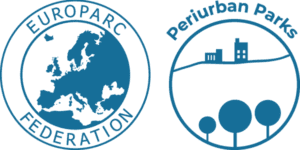
Previous Webinars
Sustainable Tourism: Training Event!
Sign up for this “Train the Trainer” event organised in the context of the ERASMUS+ project “Sustainable Tourism Training for Tomorrow” from the 22 – 24th of March 2021. If possible it will be face to face, if not it will be done online. Applications open from 23rd of November till 17th of December.
Protected areas (PAs) have an important role in tourism, both as places of visitation and recreation, and as net contributors to regional and national economies. At the same time, it is widely recognised that one of the biggest challenges is the sustainable conservation and management of the natural resources that support it. The Erasmus+ project Sustainable Tourism Training for Tomorrow, aims to contribute to this by enabling everyone with an interest in sustainable tourism in Protected Areas, to generate knowledge, tools and inspiration. Within the project, we created a free, online platform that bundles relevant theoretical, as well as practical information and insights into the topic of sustainable tourism in Protected areas. We are now producing a training toolkit to support the curriculum topics that have been developed, which will involve the production of guidelines, tools and approaches to use platform material on blended and/or face-to-face training sessions, to enable dissemination of the curriculum via physical and online training events into the future. For that we are offering around 20 places to be trained in the use of the toolkit and to provide multiplier information and capacity building in sustainable tourism across your networks.
How the training will work
We are looking for 20 people from across Europe to take part in the TOOLKIT training. This is an international project so we need people with good levels of English. Our aim is to ensure that we have a representative sample of different people working with Sustainable Tourism in Protected Areas, from people working with the park, from the community and local tourism businesses. We will be looking for a good range of ages and gender mix.
By early 2021 you will know if you have been selected! The indicative application process schedule is as follows:
- Application due by December 17th 2020
- Final selection process completed by 15th January 2021 taking into account the need for good cross representation of possible project participants
- Outcomes notified to all applicants by 18th January 2021.
In 2021, successful applicants will have the opportunity to work with and test new TOOLKIT both online using digital e-learning tools and (if regulations permit) at a 2 day workshop in Germany from March 22nd-24th. Attendance is compulsory so your availability on these dates is crucial.
The costs of this training offer is only €100 which includes the workshop and all online training. You will need to make your way to Alfred Toepfer Academy for Nature Conservation , in Schneverdingen, Germany in March. A programme of online training events will take place through February 2021.
Interested? Good!
We will need your commitment and time to participate throughout the project, but this will not be
‘full-time’ – we know you are busy people! So…
- You can learn at your own pace! Pick the time that suits you best to use the project materials and e-learn!
- Some things will be ‘fixed in time’ – for example, some online training events, live webinars and the March workshops. However, even if you can’t be free to join one of the events, they are recorded and will be available for you to ‘catch-up’ when you can. Also, we will do our very best to announce the fixed time components of the project well enough in advance to help you to plan ahead.
- We estimate that on average you will only need to commit about 2 hours per week to participate through February and March.
Our commitment to you
We will do all we can to secure your active involvement, feedback and ideas. Together with you, we will be able to demonstrate that your work and experience matter and are vitally important for the development of sustainable tourism in protected areas.
We hope to arm you with skills, knowledge and competencies that will enable you to share training in sustainable tourism with your colleagues and network.
You can find out more about the project here: https://sttft.eu/
Who should apply?
We are looking for people keen to learn how to share knowledge about and skills in delivering sustainable tourism in protected areas.
The one thing we request is that you should be actively working in Sustainable Tourism in a Protected Area, whether that be in a tourism business, within the municipality, community or in the park itself.
It is also important that you show how you would use the training given to disseminate and share with others.
To apply, please click here to fill out the application form in full.
Workshop outcomes: Why does our marine environment merit special attention?
Kornati National Park (HR) © Photo Najada Diving Ltd
During the ONLINE Conference 2020, EUROPARC held 8 thematic workshops to discuss diverse topics related to practice and capacity building in Protected Areas (PAs). In case you have not attended, or want to remind yourself of their outcomes, a series of articles summarises the content of some of these workshops.
Marine Protected Areas
The Marine workshop welcomed 22 participants from different backgrounds. At the start of the session, a short overview reminded us the importance of biodiversity in our lives, the main factors that are contributing to its decrease and how the Biodiversity Strategy aims to halt the biodiversity lost.
Especially, a brief review of the Biodiversity Strategy 2010’s targets concerning the marine environment was done, which stated that at least 10% of the sea surface should be protected by 2020, and a comparison of the goals with the current protections status.
Download the workshop introductory presentation delivered by Fernando Pinillos and Stefania Petrosillo from EUROPARC.
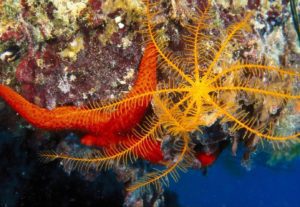
Torre Guaceto Marine Protected Area (IT) – Park Archive
A short review of the recently published Biodiversity Strategy 2030 followed with its implications for the marine environment and the management of Marine Protected Areas. This new release of the Biodiversity Strategy states three key aspects to be reached by 2030 that we considered of particular interest for the designation and management of MPAs across Europe:
- Increase the protection of the sea surface from the previous 10% to a 30%;
- Strictly protect the 10% of the marine surface;
- Achieve effectively managed MPAs.
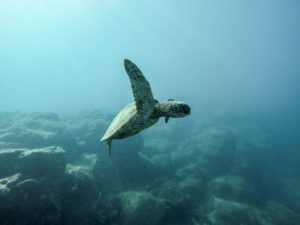
Photo: Jeremy Bishop
These three aspects raise different questions regarding the meaning of those protection levels – should the 30% be a common goal all over Europe, or for each region or country? Does strict protection mean no human activity is allowed, or no extraction, or any other meaning? What does effectively managed mean, and how it is measured?
These different concerns were raised after the introduction and discussed with the participants. Among the questions and comments received, the most important were related to the following:
- Should the 30% be a common goal all over Europe, or for each region or country?
- Does strictly protection mean no human activity is allowed, or no extraction, or any other meaning?
- What does effectively managed mean, and how it is measured?
LIFE INTEMARES project
“Needs and competencies for building the capacity of Marine Protected Area managers and stakeholders involved LIFE IP INTEMARES project (Spain)“ by Paloma Pacheco (LIFE IP INTEMARES project Coordinator).
INTEMARES project has scheduled 50 actions to be undertook before 2024, and has coordinated the design of over 80 MPA management plans, constituting one of the biggest integrated projects of this kind in Europe.
In this presentation, Paloma Pacheco explained how the INTEMARES project targets to designate and manage Marine Protected Areas in Spain covering the 18% of the sea surface of this country. Furthermore, she detailed how, through a participatory process that took place from 2017 to 2019, involved 2000 entities and used the Collective Intelligence software, they managed to identify the obstacles and needs that MPA stakeholders will need to overcome for an effective management of marine sites.
Discussion on capacity building
After the presentation, the floor was given to the participants that wanted to contribute and give answers to questions such as the implications of the Biodiversity Strategy 2030, what capacity building tools and programmes are needed for an effective MPAs co-management at all levels, and what practical competencies Protected Areas staff need to be able to do their work.
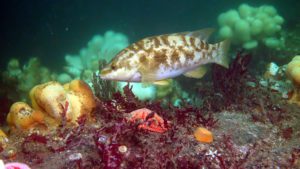
Ballan Wrasse, Arran Coast – photo by Howard Wood
Among the workshop outcomes, some relevant aspects were highlighted:
- Among the restoration actions, there is a need of rewilding big mammals and top predators, as their populations have decreased and they play a crucial role for a good functioning of ecosystems;
- The necessity of designating ecological corridors, and to set specific actions/legislation framework for transboundary areas and ecologically connected areas, as this is not only stated in the Biodiversity Strategy but also a known need to protect high mobile species;
- Lack of funding is not always the first issue when it comes to effective MPA management – this was collected during the INTEMARES participatory process. However, funding is necessary when immediate enforcement measures should be put into place;
- Among the different competencies that MPA managers and stakeholders should be trained in, conflict resolution is one of the priorities.
- Among the needs identified to effectively manage MPAs, it is critical to manage stakeholders expectations and to allow them to sit together to establish a conversation.
- Among the tools needed to improve competencies of MPA managers and stakeholders, is important to develop communication tools and active learning methodologies.
- Among the impacts arising from the new Biodiversity Strategy, it is important to differentiate between three levels of action, each of which requires different competencies:
- Designation of MPAs;
- Management of MPAs;
- Effective management of MPAs.
